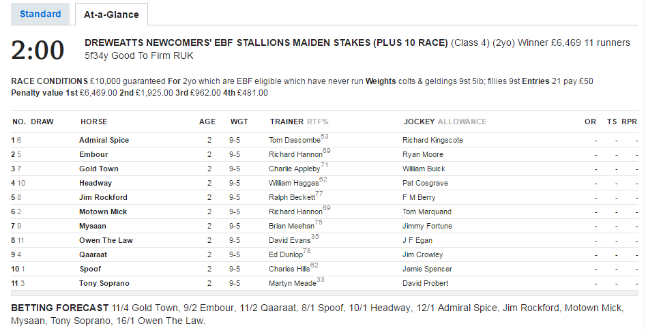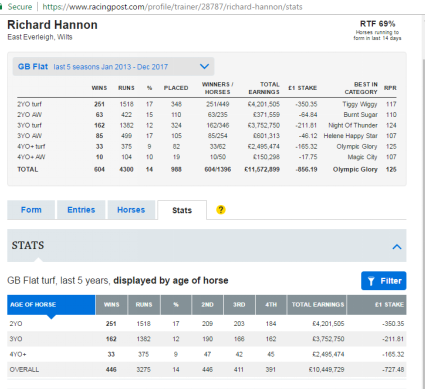I do hope you enjoyed the extended Easter break. It was odds-on, I’m afraid, that I would eat at least three quite large chocolate eggs, thus reinforcing my ‘Adonis’-like body.
In the world of horse racing, we are heading from the Jumps season and into the Turf Flat season. In the world of football, we are heading into the business end of the season.
Let’s look first at the Turf Flat season. It has some very unique components. One component is races such as this one below:

Here we have a typical two-year old Maiden race. These horses have never been on a race track before. There is no form to work with. So how do we fathom these races?
You can look at the trainers’ stats with two-year-olds. You don’t even need to be a member of www.racingpost.com in order to access that info. Click on the trainer’s name in the race card.
There is a great filter facility where you can check the trainer’s performance by age of horse. Take Richard Hannon for instance, he is not the punter’s friend with his two-year-olds in the last five years.

Do you see the filter above? That provides you with a number of options. If you had backed Richard Hannon’s two-year-olds in the last five years to level stakes, you would have a -350.35 point loss. OUCH!
This is one way to check potential bets in these two-year-old Maiden races. Another method I like to use is the market!
The bookies make it their business to know which of these two-year-old horses has shown the greater potential on the gallops. The bookies also have ‘tells’ which, if you know how to read them, can indicate a horse where those-in-the-know have put down a substantial bet.
In order to read the market, we need a comparator. I use the Racing Post Betting Forecast. Do remember those that the Betting Forecast is a fat-assed guess on behalf of the Racing Post journalist assigned to this meeting.
Historically, the Betting Forecast has been accurate.
Now what I do is to compare the Betting Forecast to the live odds. The live odds will appear at the race card at www.racingpost.com. Note down those horses whose live odds are significantly shorter than the Betting Forecast.
As an example, take Owen The Law from the above race: 16/1 in the Betting Forecast. If the live odds were to show, say, 10/1 about the horse, and then drop to 8/1, I would be interested and back the horse each-way. It may be a gamble afoot.
The assumption, as I said before, is that the Betting Forecast in the Racing Post is an accurate portrayal of the actual live odds.
A second unique characteristic this Turf Flat season is the draw.
Look at the race card above and you will see the draw column next to the horses’ number column. There are two websites I use to check the draw bias at any venue. Do remember to check draw bias by number of runners and by distance run.
The first website – www.drawbias.com – is an obvious starting point. I am working through this website currently and noting only the ultra-strong draw biases. I will pass them on once the work is done.
The second website – https://www.flatstats.co.uk/course-draw-biases.php – has tabulated the draw bias for the last ten years by course, going, distance and field size. The columns can be sorted to suit.
Chester’s May meeting will showcase the importance of the draw. This course, and courses like Beverley, need the punter to factor in the effect of the draw.
Enjoy the Turf Flat. Try reading the markets in Maiden races where there is no form. The market should be king!
